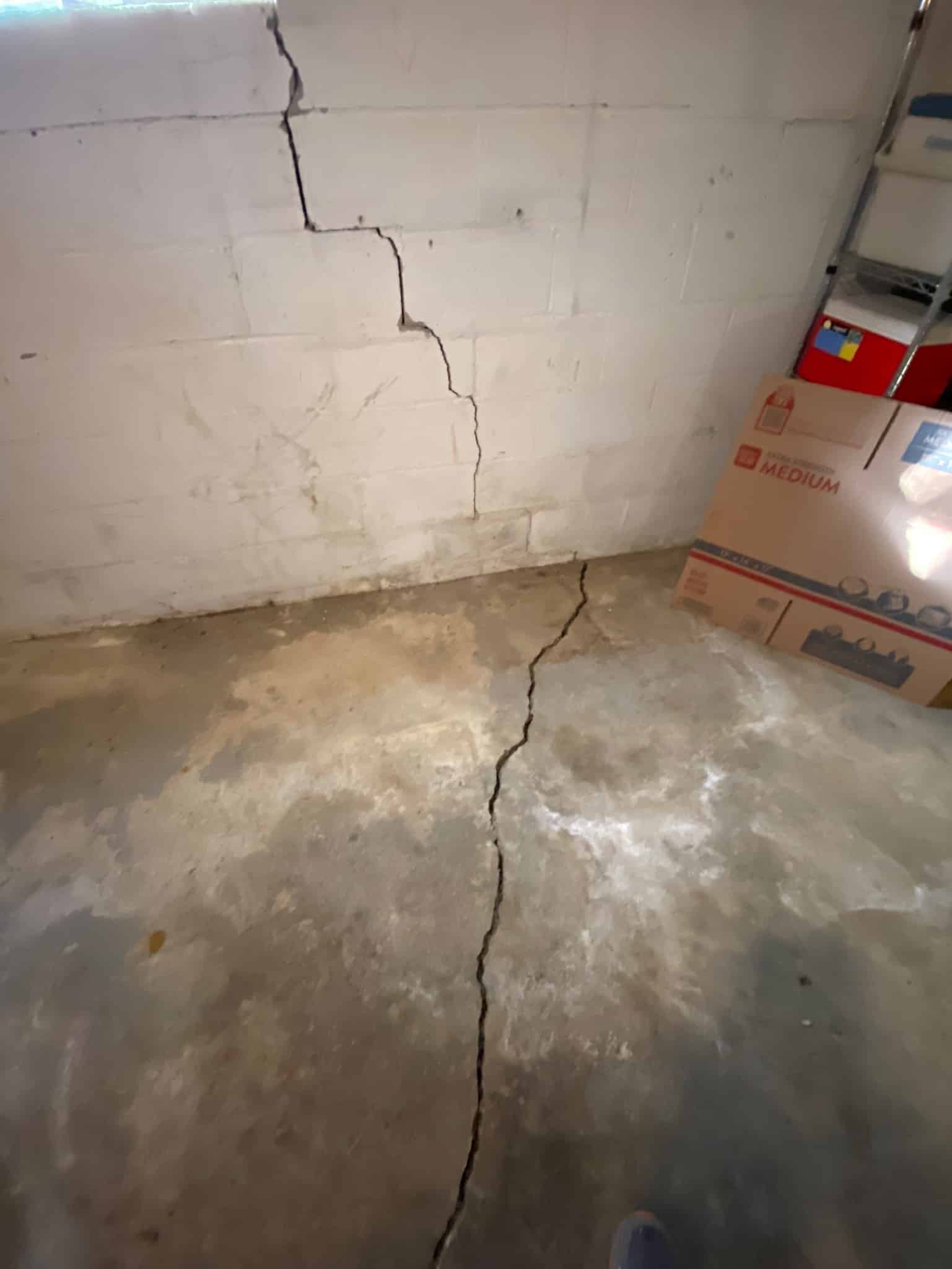
You’ve probably noticed that homes in Chantilly often face foundation issues. Ever wondered why? The culprit is usually the city’s unique blend of geographical factors, weather conditions, and construction norms. The local soil, notorious for its expansive clay and sandy compositions, doesn’t play nice with foundations. Throw in our wild weather swings and heavy rainfall, and you’ve got a recipe for instability. But that’s just scratching the surface. There’s a lot more to understand about this pervasive problem and how to protect your property’s value.
Key Takeaways
- Local soil types in Chantilly, like expansive clay or sandy soil, can cause foundation instability due to moisture changes and erosion.
- Weather conditions, including temperature fluctuations and heavy rainfall, can compromise foundation stability in Chantilly.
- Certain construction practices in Chantilly may not fully eliminate risks of foundation issues, necessitating regular inspections and maintenance.
- Common foundation problems in Chantilly include settlement cracks, moisture intrusion, wall cracks, and misaligned doors and windows.
- Delayed action on foundation issues can significantly decrease home value, urging homeowners in Chantilly to prioritize early detection and prevention.
Geographical Features of Chantilly, VA
Innumerable geographical features in Chantilly contribute to foundation issues in homes. Understandably, you might wonder how these features impact your home’s foundation. Well, it’s quite simple. The ground beneath your house isn’t just dirt; it’s a complex mixture of soil, rock, and other geological materials.
To fully comprehend how these elements can affect your foundation, let’s explore topography analysis and geological surveys. Topography analysis gives you an understanding of your property’s location relative to the surrounding landscape. It checks for potential threats, such as slopes that could result in soil erosion and subsequent foundation damage.
On the other hand, geological surveys go deeper, literally. They look at the type of soil and rock beneath your property. Some soils expand and contract with moisture changes, exerting pressure on foundations.
Rocks can also pose problems if they’re prone to shifting or if they’re not solid enough to support your home’s weight.
Chantilly’s Weather Conditions
Let’s take a moment to contemplate Chantilly’s weather conditions and how they can impact your home’s foundation.
Extreme temperature fluctuations, heavy rainfall, and winter snowfall are major factors to keep in mind.
Each of these elements can cause significant damage if your foundation isn’t properly prepared.
Extreme Temperature Fluctuations
The dramatic dance of extreme temperature fluctuations in your city is a silent enemy to your home’s foundation. You mightn’t realize it, but temperature extremes can seriously compromise your foundation stability.
During the sweltering summers, the soil around your home expands as it dries out. This expansion puts pressure on your home’s foundation, causing it to shift.
Then, as winter cloaks your city in its icy grip, the soil contracts. This constant expansion and contraction can cause your foundation to crack and weaken over time.
It’s a sneaky process. One day, you’re enjoying the warmth of summer, the next, you’re bundling up against the winter chill. All the while, your home’s foundation is under siege by these fluctuating temperatures.
It’s not something you can see or feel, but it’s happening beneath your feet. This cycle of expansion and contraction due to temperature fluctuations is a major reason why homes in your city experience foundation issues.
It’s an unavoidable reality of living in a region with such diverse weather conditions. So, what can you do about it? That’s a discussion for another day. But for now, be aware that this silent enemy is at work.
Heavy Rainfall Impact
While fluctuating temperatures pose a considerable threat to your home’s foundation, they’re not the only culprits to keep in mind.
Consider the impact of heavy rainfall. In Chantilly, severe storms are a common occurrence, creating challenges in rainwater drainage, especially in areas where the infrastructure isn’t well prepared for such deluges.
You see, when rainwater drainage is ineffective, soil saturation becomes a significant issue. As rainwater accumulates, the soil around your home soaks up the moisture like a sponge, expanding in size and weight.
This leads to a significant increase in pressure against your home’s foundation. Over time, this pressure can cause the foundation to crack, bow, or even shift, leading to serious structural damage.
Winter Snowfall Damage
Even though Chantilly is no stranger to the charm of winter snowfall, it can spell disaster for your home’s foundation.
You see, the problem starts with the snow load, the weight of the snow on your roof and around your home. If your home wasn’t built to withstand this weight, you could end up with serious foundation problems.
When snow starts to pile up, it adds extra pressure on your home’s foundation. This pressure can cause it to crack, leading to costly repairs.
But that’s not all. The snow load can also block your home’s drainage system, leading to water buildup around your foundation. This can cause further damage.
Then there’s ice accumulation. As temperatures fluctuate, snow can melt and refreeze, forming layers of ice.
This ice can expand and contract, putting even more pressure on your foundation. Over time, this can lead to severe foundation issues.
Construction Practices in Chantilly
Now, let’s turn our attention to construction practices in Chantilly.
We’ll explore common building methods and how soil type can impact these practices.
Understanding these factors will help you better address potential foundation issues in your Chantilly home.
Common Building Methods
In the heart of Chantilly, construction practices reflect a blend of tradition and technology. You’ll find homes built using time-honored techniques, yet incorporating modern, sustainable building methods. These methods aren’t just trendy; they’re essential to combat the city’s common foundation issues.
Consider retrofitting solutions, for example. This approach involves updating existing structures for improved safety and efficiency. It’s a common practice in Chantilly, and for a good reason. Retrofits can strengthen foundations, increasing a home’s resistance against common issues like subsidence or cracking.
Many builders in Chantilly also utilize advanced design software to anticipate potential foundation problems before construction begins. This proactive approach can save homeowners significant time, money, and stress down the line.
But remember, even the most advanced construction method can’t fully eliminate the risk of foundation issues. It’s vital to regularly inspect your home for signs of foundation problems and seek professional help if needed.
Soil Type Impact
Before delving into the various construction practices in Chantilly, it is vital to understand the profound impact soil types can have on a home’s foundation. Different types of soil, such as clay and sandy soil, behave differently under pressure and with varying moisture levels.
Clay soil is known for its high soil compaction and soil expansion characteristics. When it’s wet, it swells and when dry, it contracts. This constant state of flux can cause significant stress on your home’s foundation. Sandy soil, on the other hand, provides excellent soil drainage but is prone to soil erosion, which can lead to an unstable foundation.
To minimize foundation issues, builders must consider soil stabilization techniques that increase soil’s resistance to erosion, compaction, and expansion. This can be achieved through methods that alter the soil moisture content, among other factors.
Here’s a quick comparison of the two soil types:
| Soil Type | Pros | Cons |
|---|---|---|
| Clay Soil | High compaction, less erosion | High expansion, changes with moisture |
| Sandy Soil | Good drainage, less expansion | High erosion, less compaction |
Understanding the soil type in Chantilly is a significant first step in addressing potential foundation issues.
Common Foundation Issues Observed
Dealing with foundation problems in your Chantilly home? You’re not alone. Many homeowners here grapple with a range of issues, and two of the most common are settlement cracks and moisture intrusion.
Settlement cracks, as the name suggests, occur when your home’s foundation settles over time. This might sound like a natural process, but it’s crucial to not overlook it.
These cracks can vary in size, from hairline fractures that are barely visible to large gaps that are hard to miss. They might appear on your walls, ceilings, or floors, and they’re a clear sign that your foundation is under stress.
Moisture intrusion is another common problem. This occurs when water finds its way into your home, usually through the foundation.
This can lead to a host of problems, including mold and mildew growth, water damage, and even structural issues. It’s imperative to deal with moisture intrusion promptly to prevent these problems from escalating.
Understanding these common foundation problems is the first step in addressing them.
Stay tuned for our next section, where we’ll discuss the impact of these issues on Chantilly homes.
Impact on Chantilly Homes
Now that we’ve shed light on common foundation issues, let’s examine their impact on your Chantilly home.
Initially, the effects might be invisible to you. However, as the foundation instability worsens, you’ll notice unsettling changes.
Cracks may begin to form on walls, doorways, or windows as the shifting foundation disrupts the structural integrity of your home. Floors may begin to sag or become uneven. You’ll notice doors and windows becoming harder to close, indicating a shift in the frame alignment.
It’s important to understand these aren’t just aesthetic issues. They’re signs your home’s foundation stability is compromised.
The repercussions are more than cosmetic. They can affect the overall safety of your property, making it unsafe for occupancy.
Additionally, the value of your home could take a significant hit. Potential buyers are less likely to invest in a property with known foundation issues, and you may be forced to drastically reduce the asking price to make a sale.
Preventative Measures for Homeowners
Every homeowner in Chantilly can take certain steps to prevent foundation problems.
It’s all about foundation maintenance and guaranteeing structural integrity. Start by keeping an eye on your home’s drainage. Excessive water can lead to soil expansion, putting pressure on your home’s foundation. Confirm your gutters and downspouts divert water away from your home, and consider landscaping solutions that encourage water runoff.
Next, keep an eye on the trees around your property. Their roots can grow into the foundation, causing cracks and other damage. If you’re planting new trees, make sure they’re far enough away from the house to prevent future issues.
Maintaining the moisture level in your soil is also essential. Too much moisture can cause expansion, while too little can lead to soil contraction. Both scenarios can lead to foundation problems. Invest in a good irrigation system to maintain a consistent moisture level.
Lastly, regular inspections are key to maintaining structural integrity. Hire a professional to inspect your foundation at least once a year.
They’ll spot potential issues before they become costly repairs. Remember, prevention is always better, and often cheaper, than a cure.
Frequently Asked Questions
What Are the Common Signs of Foundation Issues in My Home?
You’re likely experiencing foundation issues if you’re spotting cracked walls or uneven floors in your home.
These signs shouldn’t be ignored as they’re usually indications of serious underlying issues.
Cracked walls, especially horizontal ones, reveal stress from shifting soil.
Uneven floors can signal house settling or sagging.
It’s important you get a professional to assess these problems to prevent further damage to your home.
Does Home Insurance Cover Foundation Repairs?
Typically, your home insurance won’t cover foundation repairs. Most policies consider such issues part of your home’s maintenance, which isn’t covered.
However, if the damage is due to an insured risk like fire or water, you might’ve some coverage. But, you’ll need to check your policy’s specific coverage limitations.
It’s always a good idea to talk to your insurance provider about foundation insurance and what it entails.
How Much Does It Typically Cost to Fix Foundation Problems?
You’re probably wondering about the typical cost to fix foundation problems.
It’s not a simple answer. Foundation repair costs can vary greatly depending on the severity of the issue and the foundation repair methods used.
Minor repairs might only set you back a few hundred dollars. But for major issues, you could be looking at tens of thousands.
It’s important to get an accurate quote from a reputable company to understand your potential costs.
Are There Any Specific Local Regulations Regarding Foundation Repairs?
Yes, there are specific local regulations regarding foundation repairs.
It’s crucial to familiarize yourself with your local building codes. These codes often require you to obtain foundation repair permits.
They’re in place to guarantee safety and quality of work. Not complying can lead to fines, so it’s vital to do your homework.
Reach out to your local building department for accurate, up-to-date information.
Don’t risk ignoring these important guidelines.
How Long Does a Foundation Repair Typically Take?
A foundation repair’s timeline can greatly vary.
You’re typically looking at a few days to a week for basic repairs. However, if your home has severe damage, it could extend to a few weeks.
The repair process begins with an inspection, then a plan is developed and implemented.
Conclusion
So, you now understand why homes in Chantilly often battle foundation issues. It’s a mix of our local geography, weather patterns, and building practices. But remember, these problems can be managed with regular maintenance and proactive steps. Don’t let your home’s value take a hit. Stay ahead of potential issues and protect your investment. After all, it’s more than just a house, it’s your home.

Seal-tite Basement Waterproofing Co. is a full service basement environment contractor. We carry an A+ Better Business Bureau rating. We repaired over 40,000 homes and structures in Virginia, West Virginia, Tennessee, and North Carolina. We are fully insured and licensed. We have worked in all types of locations, including residential and commercial locations, government agencies, colleges, hospitals, churches, and condo associations.
Seal-tite® offers a lifetime transferable warranty. We carry a Class A Contractor’s License and we are fully insured. Our satisfied customers range from government agencies to businesses, hospitals, colleges, churches, and thousands of homeowners. Your home is probably the single largest investment you will make in your lifetime. Don’t wait, call Seal-tite® to help make your home dry, safe and livable.

